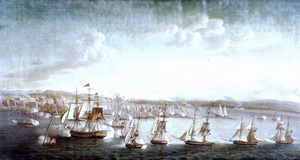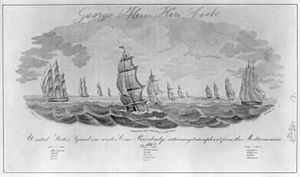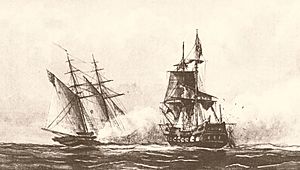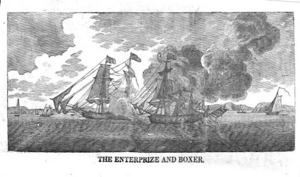USS Enterprise (1799) facts for kids
The third US ship to be named Enterprise was a schooner, built by Henry Spencer at Baltimore, Maryland, in 1799. Her first commander thought that she was too lightly built and that her quarters, in particular, should be bulletproofed. Enterprise was overhauled and rebuilt several times, effectively changing from a twelve-gun schooner to a fourteen-gun topsail schooner and eventually to a brig. Enterprise saw action in the Caribbean, the Mediterranean, and the Caribbean again, capturing numerous prizes. She wrecked in July 1823.
Contents
First Caribbean tour
Lieutenant John Shaw commissioned Enterprise. On 17 December 1799, during the Quasi-War with France, Enterprise departed the Delaware Capes for the Caribbean to protect United States merchantmen from the depredations of French privateers. Within the following year, Enterprise captured eight privateers and liberated 11 American vessels from captivity, achievements that assured her inclusion in the 14 ships retained in the Navy after the Quasi-War. Placing her for sale was suggested in mid-March 1801.
First arrival in Mediterranean
After Lieutenant Shaw, due to ill health, was relieved by Lieutenant Andrew Sterett, Enterprise sailed to the Mediterranean. The need for new masts delayed her departure from Baltimore until early May 1801. She reached Gibraltar on 26 June 1801, where she was to join other U.S. warships in the First Barbary War.
Battle with corsair Tripoli
Enterprise's first action came on 1 August 1801 when, just west of Malta, she defeated the 14-gun Tripolitan corsair Tripoli, after a fierce but one-sided battle. Enterprise emerged unscathed and sent the battered pirate into port.
The action was described in Washington City's National Intelligencer & Adv. on 18 November 1801.
On 3 February 1802, the U.S. Congress resolved that Sterett receive a commemorative sword; the rest of Enterprise's crew received a month's pay.
Remainder of Mediterranean patrol
At Gibraltar on 3 October 1801, Enterprise was ordered to return to Baltimore with dispatches for the Secretary of the Navy. While in port, Sterett received orders on 17 November to pay off and discharge the crew. He was advised that he would receive a furlough and replaced after he oversaw the ship's refitting. Master Commandant Cyrus Talbot was offered the command, but he was discharged 23 October 1801, under the Peace Establishment Act.
Enterprise's next victories came in 1803 after months of carrying despatches, convoying merchantmen, and patrolling the Mediterranean. On 17 January, she captured Paulina, a Tunisian ship under charter to the Bashaw (Pasha) of Tripoli, and on 22 May, she ran a 30-ton craft ashore on the coast of Tripoli. For the next month Enterprise and other ships of the squadron cruised inshore, bombarding the coast and sending landing parties to destroy enemy small craft.

On 12 November 1803 Stephen Decatur assumed command of Enterprise. On 23 December 1803, after a quiet interval of cruising, Enterprise joined with frigate Constitution to capture the Tripolitan ketch Mastico. The captured vessel was taken back to Syracuse and refitted and renamed Intrepid. Command was then turned over to Enterprise's commander Lieutenant Decatur. Because of her regional appearance the ketch was well suited for making its way into Tripoli's harbor without raising suspicion and was used in a daring expedition to board, capture and burn the frigate Philadelphia, captured by the Tripolitans and anchored in the harbor of Tripoli. Decatur and volunteers from Enterprise carried out their mission almost perfectly, destroying the frigate and depriving Tripoli of a powerful warship.
Enterprise continued to patrol the Barbary Coast until July 1804 when she joined the other ships of the squadron in general attacks on the city of Tripoli over a period of several weeks.
Enterprise passed the winter in Venice, Italy, where she was practically rebuilt by May 1805. She rejoined her squadron in July and resumed patrol and convoy duty until August 1807. During that period she fought (15 August 1806) a brief engagement off Gibraltar with a group of Spanish gunboats that attacked her but which she was able to drive off. Enterprise returned to the United States in late 1807, and cruised coastal waters until June 1809. After a brief tour in the Mediterranean, she sailed to New York where she was laid up for nearly a year.
1811 recommissioning
Repaired at the Washington Navy Yard, Enterprise was recommissioned there in April 1811, then sailed for operations out of Savannah, Georgia, and Charleston, South Carolina. She returned to Washington on 2 October and was hauled out of the water for extensive repairs and modifications: when she sailed on 20 May 1812, she had been rerigged as a brig.
At sea when war was declared on Britain, she cruised along the east coast during the first year of hostilities. On 5 September 1813, Enterprise sighted and chased the brig Boxer. The brigs opened fire on each other, and in a closely fought, fierce, and gallant action which took the lives of both commanding officers, Enterprise captured Boxer and took her into nearby Portland, Maine, with Edward McCall in command. Here a common funeral was held for Lieutenant William Burrows, Enterprise, and Captain Samuel Blyth, Boxer, both well known and highly regarded in their respective naval services. Both Burrows and Blyth were buried in the Eastern Cemetery in Portland near the grave of Commodore Edward Preble.
Second Caribbean patrol
After repairing at Portland, Enterprise sailed in company with brig Rattlesnake, for the Caribbean. The two ships took three prizes before being forced to separate by a heavily armed ship on 25 February 1814. Enterprise was compelled to jettison most of her guns in order to outsail her superior antagonist. The brig reached Wilmington, North Carolina, on 9 March 1814, then passed the remainder of the war as a guardship off Charleston, South Carolina.
Mediterranean, New Orleans, and West Indies Squadrons

Enterprise served one more short tour in the Mediterranean Squadron (July–November 1815), then cruised the northeastern seaboard until November 1817. In 1818 she was under the command of Lieutenant Lawrence Kearny of the New Orleans Squadron, who evicted Jean Lafitte from Galveston, Texas. From that time on she sailed the Caribbean Sea and the Gulf of Mexico as one of the founding vessels of what later became the West Indies Squadron in 1821. She was active in suppressing pirates, smugglers, and slavers; in this duty she took 13 prizes. An attack on Cape Antonio, Cuba in October 1821 resulted in the rescue of three vessels taken by pirates, and the breaking up of an outlaw flotilla reputedly commanded by James D. Jeffers, aka Charles Gibbs.
Fate
Enterprise's career ended on 9 July 1823, when she stranded and broke up on Little Curacao Island in the West Indies. Her crew suffered no casualties.
Legacy
For her illustrious career, the ship earned the nickname "Lucky Enterprise". The yacht that defended the 1930 America's Cup was named after her, and sailed with a model of her in the captain's cabin.
| Preceded by 1775 |
USS Enterprise 1799–1823 |
Succeeded by 1831 |
See also
- List of historical schooners
- List of ships of the United States Navy named Enterprise
- Bibliography of early American naval history
- The fictional Star Ship USS Enterprise, featured in the Star Trek television and films series, is named after the real life line of naval vessels named Enterprise.



